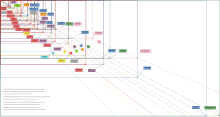
Back 720p Arabic 720p Azerbaijani 720p Catalan 720p German 720p Greek 720p Spanish ۷۲۰پی Persian 720p Finnish 720p French 720p HE

720p (720 lines progressive) is a progressive HD signal format with 720 horizontal lines/1280 columns and an aspect ratio (AR) of 16:9, normally known as widescreen HD (1.78:1). All major HD broadcasting standards (such as SMPTE 292M) include a 720p format, which has a resolution of 1280×720.
The number 720 stands for the 720 horizontal scan lines of image display resolution (also known as 720 pixels of vertical resolution).[1] The p stands for progressive scan, i.e. non-interlaced. When broadcast at 60[note 1] frames per second, 720p features the highest temporal resolution possible under the ATSC and DVB standards. The term assumes a widescreen aspect ratio of 16:9, thus implying a resolution of 1280×720 px (0.9 megapixels).
720i (720 lines interlaced) is an erroneous term found in numerous sources and publications. Typically, it is a typographical error in which the author is referring to the 720p HDTV format. However, in some cases it is incorrectly presented as an actual alternative format to 720p.[3] No proposed or existing broadcast standard permits 720 interlaced lines in a video frame at any frame rate.[4]
- ^ "720p – AfterDawn: Glossary of technology terms & acronyms".
- ^ Hoffner, Randy (2008-01-09). "Will the End of NTSC Be the End of 59.94?". TVTechnology. Retrieved 2010-10-08.
- ^ Briere, Daniel; Patrick Hurley (2006). HDTV for Dummies. For Dummies. p. 13. ISBN 9780470096734.
- ^ "ATSC Standard: Video System Characteristics of AVC in the ATSC Digital Television System" (PDF). 2008-07-29. Archived from the original (PDF) on 2012-10-04. Retrieved 2011-07-24.
Cite error: There are <ref group=note> tags on this page, but the references will not show without a {{reflist|group=note}} template (see the help page).